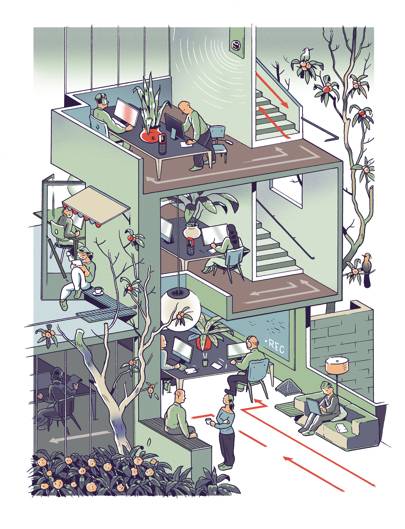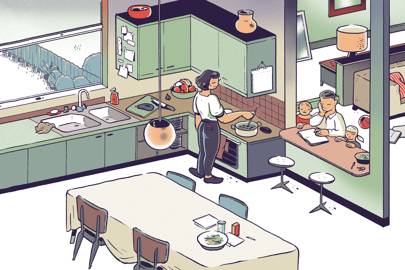Source: https://www.wired.co.uk/article/coronavirus-pandemic-office-homes
June 2020
Credit: Jan Van Der Veken
Whether it's the tape markers at two-metre intervals on supermarket floors, or Plexiglas screens in restaurants, the physical dividers invading our lives look and feel like hastily put-together fixes, architectural sticking plasters for spaces built with commingling in mind. But what would it look like for our housing, workplaces and cities to be permanently designed for the extended social distancing that will follow the coronavirus pandemic? And how will we change the way we live to guard against future outbreaks?
According to Emily Sargent, senior curator at the Wellcome Collection and the lead on its 2019 Living with Buildings exhibition, there is a window of opportunity to reexamine the relationship between the built and natural environment, and how it affects everything from work to where we recover from illness. "We've lost track of concerns like ventilation as principles of health," she says. "There are all kinds of ways in which this enforced spotlight on the home surfaces lots of things that home can mean to people. These sometimes aren't what we might hope – comfort, security, shelter – but instead elements that can put physical and mental health at risk." The short-term, safety-minded solutions of mid-2020 have no fixed timeframes – all the more reason to make them count
The home: open outdoors, closed inside
The challenges facing housing are as much structural and political as they are architectural but there is scope to design for future pandemics. "The current regulations around amenity space – outdoor and activity space – will need to go further," says Siraaj Mitha, architect at Stanton Williams. "The limitations need to be drastically rethought for families and people living in volume housing." This could mean balconies with space for exercise and allotments with more dedicated storage capacity inside. Communal building developers will need to consider open cores, outdoor “deck access” and separate entrances to reduce the risk of transmission between units.
As for interiors, the decades-long trend towards open plan design may be finished. Walls, partitions and corridors can minimise the acoustic impact associated with working at home: "It depends which dynamic you're speaking to: a family of four or a group of housemates,” says Mitha. “People want spatial and acoustic privacy in different ways."
Transport: cycle city
Mayors and transport commissioners from Berlin to Vancouver are transferring street space from cars to cyclists. Milan's Strade Aperte plan is reshaping 35km of streets this summer with a mix of temporary and permanent measures including new cycle lanes, low traffic neighbourhoods and wider pavements. Public transport won't disappear, though. "We've been asked how you can make stations safer," says Darren Comber, CEO of Scott Brownrigg, an architecture practice which has designed parts of Paddington and Tottenham Court Road stations. "The pedestrian flow analysis will be critical; there will be barriers to get into stations, then a series of gates to restrict the flow."
The office: 9 to 5 at the cellularised business park
"We'll see a rebirth of the business park," predicts Comber. Campuses with outdoor space mean access to nature for workers and safely distanced buildings.
Instead of linear rows of desks, colleagues could sit at four sides of a square. Comber expects British Council of Offices space standards on distances between workers to be increased.
The Scott Brownrigg-designed Arm HQ in Cambridge is "heavily cellularised" with team working spaces for no more than 30, internal streets and breakout areas.
Comber plans for 50 per cent of staff to work in the studios at any one time: "For two to three years this will have an impact." To compensate, big-screen Zoom video calls will link the two teams.
Natural ventilation, like the Environment Agency's automatic openable windows, will be key. More experimental? Artificial, bacteria-destroying hydroxyl radicals in filtration systems.
Digital twins, which monitor movement and ventilation in airports like Istanbul, can be used to inform post-pandemic office design. With digital twins, it's possible to make "real time assessments on distance and segregation in a replica world, using avatars that we can make sick,” says Comber.
Sophie Charara edits WIRED Recommends. She tweets from @sophiecharara
 https://wi-images.condecdn.net/image/34o3QZ8zo9Q/crop/810/f/0720stpostpandemic02.jpg 810w,
https://wi-images.condecdn.net/image/34o3QZ8zo9Q/crop/810/f/0720stpostpandemic02.jpg 810w,  https://wi-images.condecdn.net/image/dGD3NLnY6BM/crop/810/f/0720stpostpandemic01.jpg 810w,
https://wi-images.condecdn.net/image/dGD3NLnY6BM/crop/810/f/0720stpostpandemic01.jpg 810w,
Comments